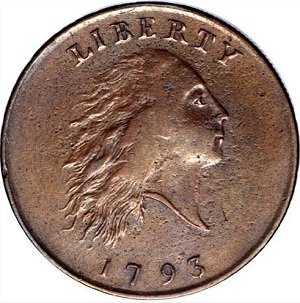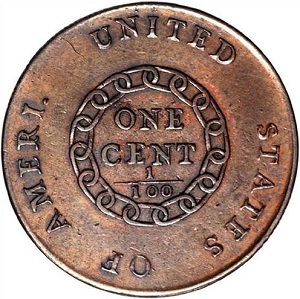1793 Flowing Hair Cent, Chain Reverse, AMERI.
Have you ever held a 1793 Flowing Hair Chain Reverse AMERI cent? Do you know it was the very first coin produced for circulation by the United States Mint?(1) History in your hands indeed!
One must wonder why the engraver of the AMERI. reverse die decided to shorten the word "America" by a net of just one space. It appears had he spelled out “America” fully, it would have disrupted the equidistant balance between the lettering on the top half of the reverse. Perhaps that’s what he had in mind, but it will probably forever remain yet another secret of the early Mint.
Soon after the Chain cents hit the streets of Philadelphia in March of 1793, it stirred controversy on multiple fronts. Aesthetically, the obverse image of Lady Liberty was ridiculed by some, for she appeared as a wild-eyed, unnerved woman with unruly hair, rather than a dignified model of calm and strength.(2)
The reverse fared no better. The chain was meant to symbolize unity, but that's not how it was viewed. How ironic, critics noted, that the first United States coin handled by the public at large highlighted a symbol suggestive of bondage? Did not this nation recently fight a revolution to win liberty for its people? Others saw the chain as representing slavery.
The Boston Argus captured the public’s sentiments over the new United States cent in an article dated March 26, 1793, when it stated: "The chain on the reverse is but a bad omen for Liberty, and Liberty herself appears to be in a fright."(3)
Under the weight of justifiable criticism, the chain was replaced by a wreath after only a few weeks of production. The calamitous Liberty portrait remained a bit longer, but it too was cast aside in September by the graceful Liberty Cap cent.(4)
Only one die pairing (Sheldon-1, or S-1 for short) was used to make the AMERI. Chain cent. The same obverse die was then “married” to a new reverse die, this one with AMERICA fully spelled, to generate the S-2 variety. The same reverse was then paired with three more obverses to generate the NC-1 (NC for non-collectible), S-3, and S-4 varieties. The S-4 is distinguished by a period following the word LIBERTY and the 1793 date.(5)
This table summarizes the die varieties of the 1793 Chain cent:
| Obverse ID | Reverse ID | Die Variety ID |
|---|---|---|
| A (No Periods) | A (AMERI.) | S-1 |
| A (No Periods) | B (AMERICA) | S-2 |
| B (No Periods) | B (AMERICA) | S-3 |
| C (No Periods) | B (AMERICA) | NC-1 |
| D (Periods) | B (AMERICA) | S-4 |
In all, 36,103 Chain cents were delivered to the Mint treasurer between March 1-12 of 1793, but there are no records indicating how many of each variety were struck. Researcher Walter Breen estimated 6,350 of those were AMERI. cents, meaning the second reverse die with the non-abbreviated AMERICA was used to strike nearly 30,000 more Chain cents.(6)
Since the 1850’s, the Chain cents of 1793 have found a soft spot in the hearts of collectors, as scarce relics from the earliest days of the United States. The AMERI. variety enjoys added distinction because of its heightened rarity.(7)
How ironic it is that during its time of service, the 1793 Chain cent was scorned for its design and lack of artistic charm. Today, it is viewed as a numismatic treasure of great historical importance.
| Estimated survivors in all grades: 187 ?
The survivor estimate from PCGS represents an average of one or more experts' opinions as to how many examples survive of a particular coin in all grades. Survival estimates include coins that are raw, certified by PCGS, and certified by other grading services. Learn more at PCGS. |
| PCGS Rarity Scale: 7.1 ?
The 'PCGS CoinFacts Rarity Scale' assesses the relative rarity of all U.S. coins, based on estimated surviving examples. The scale runs from 1.0 to 10.0. The higher the number, the rarer the coin.
Learn more at PCGS. |
| Click HERE to check for availability on eBay** |
Preview of eBay selection:
 |
 |
| Trendline Avg = 15.12 | GOOD |
Historic Value Trend Charts:
| Last updated 11-11-24 | Return to Key Date Coin List | |
| There are no Common Date comparisons for this coin. | ||
|
|
||
| Download Charts to Your Computer | ||
Sources
1. Stack's Bowers Galleries. 1793 Flowing Hair Cent. Chain, AMERI. Feb 2016 Auction.
2. Garrett, Jeff and Guth, Ron. 100 Greatest U.S. Coins, 5th ed. Pelham, AL. Whitman Publishing, 2019.
3. Stack's Bowers Galleries. 1793 Chain Cent. AMERICA. No Periods. Aug 2012 Auction.
4. Heritage Auctions. 1793 1C Chain, AMERICA. Jan 2022 Auction.
5. Stack's Bowers Galleries. 1793 Chain Cent. AMERICA. No Periods. Jan 2013 Auction.
6. Heritage Auctions. 1793 Chain 1C AMERICA. Jan 2014 Auction.
7. Stack's Bowers Galleries. 1793 Flowing Hair Cent. Chain, AMERI. Feb 2016 Auction.
**Many very fine coin dealers sell on eBay. At any point in time, there may be over one million search results for United States coins. This includes quite a few of the recommendations on our Key Date Coin List.
If you’re thinking about purchasing a rare coin, eBay is certainly worth a look. For your convenience, the links from this site to eBay are coded to bring up only coins certified by PCGS and NGC.
As is always, always the case, never buy a valuable coin from a seller whose trustworthiness cannot be verified. Learn more about this at our chapter Best Places to Buy Coins, which also has a section on doing business on eBay.
In the interest of full disclosure, Rare Coins 101 receives a small commission anytime someone connects to eBay from this site and purchases something.
Coin images by Stack's Bowers Galleries.


